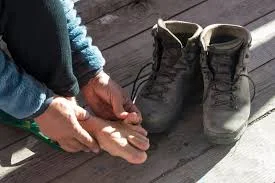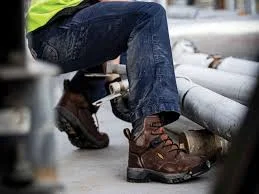Features of work boots for sore feet
Table of Contents
When it comes to the best work boots for sore feet, there are a few key features to look for:
- Cushioning: Look for boots with a padded insole and midsole to provide extra shock absorption and support for your feet. Memory foam or gel inserts are also good options.
- Arch support: If you have flat feet or other foot conditions that can cause pain, look for boots with built-in arch support. This can help to distribute weight more evenly across your foot and reduce pain.
- Wide fit: If you have wide feet, look for boots that come in wide sizes or have a roomy toe box. This will help to prevent your toes from rubbing against the sides of the boots and causing pain.
- Durable outsole: Look for boots with a durable outsole that will provide good traction and slip resistance. This is especially important if you work on a slippery or uneven surface.
- Ankle support: If you are working in an environment that requires a lot of bending or twisting, look for boots with good ankle support. This will help to prevent sprains and strains.
Examples
Some examples of work boots that have these features include:
- Timberland PRO Men’s Pit Boss 6″ Steel Toe
- KEEN Utility Men’s Pittsburgh Steel Toe Work Boot
- Rocky Men’s Core Waterproof Insulated Outdoor Boot
- Georgia Boot Men’s Georgia Giant Wellington Work Boot
- Red Wing Heritage Men’s Iron Ranger 6″ Vibram Boot
It’s important to keep in mind that the best work boots for sore feet will depend on the specific needs of your feet and the type of work that you are doing. It’s always a good idea to try on a few different styles and brands to see which ones feel the most comfortable.

Type of best work boots for sore feet
There are a few different types of work boots that can be particularly helpful for those with sore feet:
- Steel-toed boots: These are a popular choice for workers in construction, manufacturing, and other industries where there is a risk of falling objects. Steel-toed boots provide extra protection for the toes and can help to prevent pain caused by impact injuries.
- Safety boots: These boots are designed to protect the feet from a variety of hazards, such as slips, trips, and electrical hazards. They often feature slip-resistant soles, insulation, and reinforced toes.
- Waterproof boots: If you work in wet or muddy conditions, waterproof boots can help to keep your feet dry and comfortable. Look for boots that are made with waterproof materials, such as full-grain leather or rubber.
- Insulated boots: If you work in cold environments, insulated boots can help to keep your feet warm. Look for boots with a thick insulation layer, such as Thinsulate, and a waterproof membrane to keep your feet dry.
- Slip-on boots: These boots are easy to put on and take off, which can make them a good choice for those with sore feet. They often have a looser fit than other types of work boots, which can help to reduce pressure on the feet.
- Athletic work boots: These are designed with the same technology used in athletic shoes such as good arch support, padding, and cushioning, making them a good option for those who stand for long hours or have foot conditions that cause pain.
It’s important to remember that different types of boots will have different features and benefits, so it’s important to choose the one that best suits your needs and work environment.

Construction:
- Upper: The upper of a work boot is the part of the boot that covers the foot and ankle. Look for work boots that are made with durable materials, such as full-grain leather or synthetic materials, to provide long-lasting wear.
- Toe cap: A toe cap is a reinforced area at the front of the boot that provides extra protection for the toes. Look for boots that have a steel or composite toe cap to protect against falling objects and impact injuries.
- Insole: The insole is the removable or permanent cushioning layer inside the boot that provides extra support and comfort for the foot. Look for boots that have a padded insole made of materials like memory foam, gel, or EVA foam.
- Midsole: The midsole is the layer of cushioning between the insole and outsole that provides extra shock absorption and support for the foot. Look for boots with a padded midsole to help reduce foot pain.
- Outsole: The outsole is the bottom of the boot that comes in contact with the ground. Look for boots that have a durable and slip-resistant outsole to provide good traction and stability.
- Ankle support: Some work boots have additional support for the ankle, such as a padded collar or a reinforced heel cup. This can provide extra support and protection for the ankle and reduce the risk of sprains and strains.
Applications:
- Construction: If you work in construction, look for work boots that have a steel or composite toe cap and a durable outsole to provide extra protection for the toes and good traction on slippery or uneven surfaces.
- Manufacturing: If you work in manufacturing, look for work boots that have a steel or composite toe cap and good slip resistance to protect against falling objects and slips, trips and falls.
- Outdoor: If you work outdoors, look for work boots that are waterproof and insulated to keep your feet dry and warm in wet or cold conditions.
- Healthcare: If you work in healthcare, look for work boots that are slip-resistant and easy to clean to prevent slips, trips and falls and maintain hygiene.
- Service industry: If you work in the service industry, look for work boots that are lightweight and comfortable to wear for long periods of time.
It’s important to keep in mind that the best work boots for sore feet will depend on the specific needs of your feet and the type of work that you are doing. It’s always a good idea to try on a few different styles and brands to see which ones feel the most comfortable and provide the features you need.
Advantages and disadvantages of best work boots
Advantages:
- Cushioning and arch support: Work boots with padded insoles and midsoles, and arch support can provide extra comfort and support for the feet, reducing pain and fatigue.
- Durable construction: Work boots made with high-quality materials such as full-grain leather or synthetic materials are more durable and can withstand the wear and tear of heavy use.
- Safety features: Many work boots come with safety features such as steel or composite toe caps and slip-resistant soles, which can protect the feet from hazards and reduce the risk of injuries.
- Insulation and waterproofing: Some work boots are insulated and waterproof. Which can keep the feet warm and dry in cold or wet environments, making them comfortable to wear for a long time.
- Proper fit: That come in wide sizes or have a roomy toe box can help to prevent your toes. Tp Prevent from rubbing against the sides of the boots and causing pain.
Disadvantages:
- Cost: Work boots that have added features such as safety and cushioning can be more expensive than standard work boots.
- Heavyweight: Work boots that have added safety features such as steel toe caps or insulation can be heavy. Which can cause fatigue over time.
- Break-in period: Some work boots may require a break-in period before they become comfortable to wear.
- Limited style options: Work boots that are focused on safety and comfort. These features may not have as many style options as standard work boots.
- Limited breathability: Some work boots that are waterproof and insulated may not have enough breathability. Which can cause feet to get hot and sweaty.
It’s important to remember that the best work boots for sore feet will depend on the specific needs of your feet. The type of work that you are doing. It’s always a good idea to weigh the advantages and disadvantages of the different types of work boots before making a decision.
FAQ
What are the best work boots for sore feet?
There are a few key features to look for when choosing work boots for sore feet. Such as cushioning, arch support, a wide fit, durable outsole, and ankle support. Some examples include Timberland PRO Men’s Pit Boss 6″ Steel Toe, KEEN Utility Men’s Pittsburgh Steel Toe Work Boot, Rocky Men’s Core Waterproof Insulated Outdoor Boot, Georgia Boot Men’s Georgia Giant Wellington Work Boot, and Red Wing Heritage Men’s Iron Ranger 6″ Vibram Boot.
Are steel-toed boots good for sore feet?
Steel-toed boots can be a good choice for those with sore feet. Especially if you work in an industry where there is a risk of falling objects. They provide extra protection for the toes and can help to prevent pain caused by impact injuries.
Are safety boots good for sore feet?
Safety boots can be a good choice for those with sore feet. As they are designed to protect the feet from a variety of hazards such as slips, trips, and electrical hazards. They often feature slip-resistant soles, insulation, and reinforced toes.
Are waterproof boots good for sore feet?
Waterproof boots can be helpful for those with sore feet who work in wet or muddy conditions. As they will help to keep the feet dry and comfortable.
Are insulated boots good for sore feet?
Insulated boots can be helpful for those with sore feet who work in cold environments. As they will help to keep the feet warm.
Are slip-on boots good for sore feet?
Slip-on boots can be a good choice for those with sore feet as they are easy to put on and take off. It often has a looser fit than other types of work boots. Which can help to reduce pressure on the feet.
Are athletic work boots good for sore feet?
Athletic work boots are designed with the same technology used in athletic shoes. Such as good arch support, padding, and cushioning. Making them a good option for those who stand for long hours or have foot conditions that cause pain.
What kind of materials are best for work boots for sore feet?
Look for work boots that are made with durable materials. Such as full-grain leather or synthetic materials, to provide long-lasting wear. Also, look for a padded insole made of materials like memory foam, gel, or EVA foam.
Can work boots for sore feet prevent injuries?
Work boots that have added safety features such as steel or composite toe caps and slip-resistant soles. It can protect the feet from hazards and reduce the risk of injuries.
How much should I expect to spend on work boots for sore feet?
Work boots that have added features such as safety and cushioning can be more expensive than standard work boots. But the extra cost may be worth it for the added comfort and protection.
What are the best work boots for people with flat feet?
Look for work boots that have built-in arch support to distribute weight more evenly across your foot and reduce pain.
Are there work boots for sore feet that are also good for standing all day?
Athletic work boots are designed with the same technology used in athletic shoes. Such as good arch support, padding, and cushioning. It makes them a good option for those who stand for long hours or have foot conditions that cause pain.
Are there work boots for sore feet that are also good for walking long distances?
Look for work boots that have